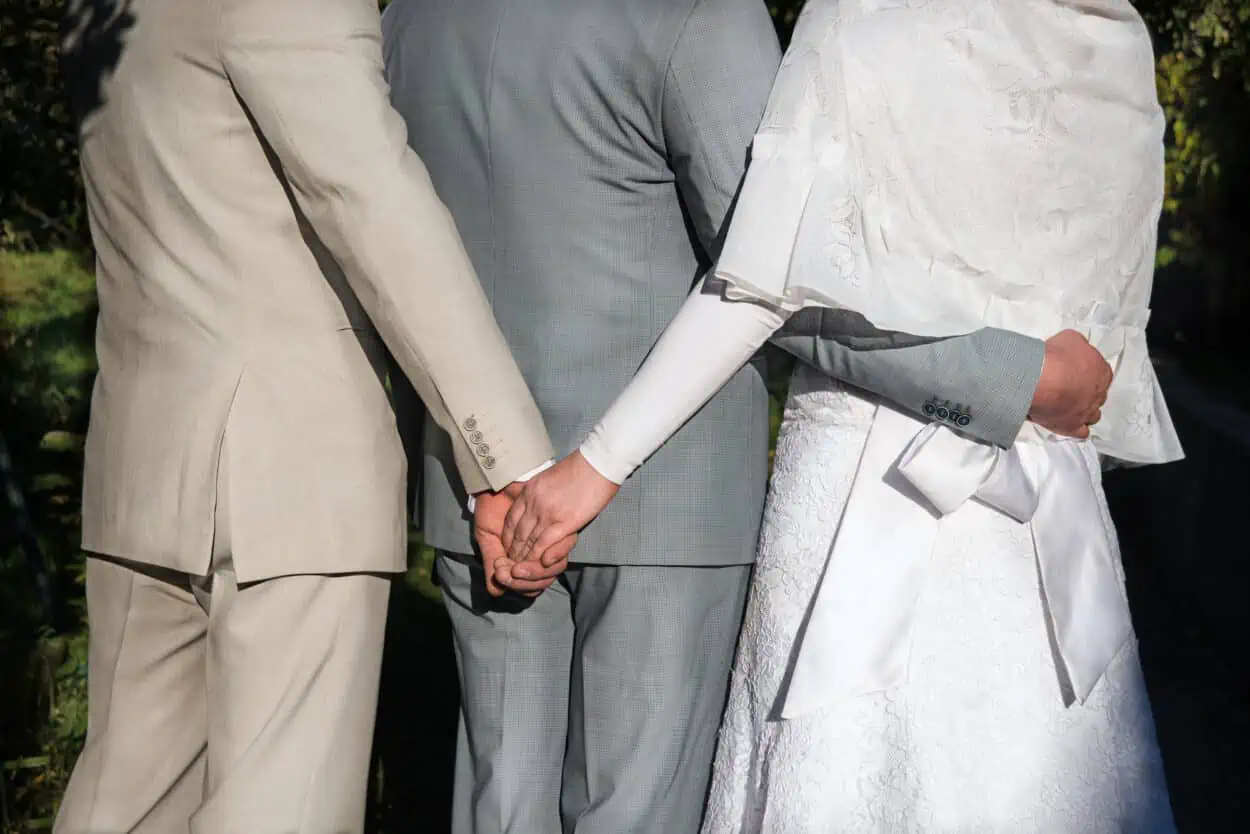
The vast majority of romantic relationships we see around us are usually monogamous.1 That’s usually true for our friends, our coworkers, and people we see in the media or elsewhere. Monogamy isn’t the only option, however, and lots of people are trying out alternative relationship structures.
In this article, we’re going to look at two major types of ethical non-monogamy (i.e. having an agreement in place rather than cheating); polygamy and polyamory. I’m going to show you the similarities and differences between them and help you if your partner is suggesting that you open up your relationship.
Table of Contents
Before we really get into a deep discussion about the differences between the various types of polygamous or polyamorous relationships, let’s start with a few clear definitions.
Polygamy
Polygamy refers to having multiple spouses. Technically, this applies to all gender combinations but it’s most commonly used synonymously with polygyny.2
Polygyny
This word is rarely used, but it refers to a polygamous relationship where a single man has multiple different wives. Given that this is the overwhelming majority of polygamous structures, most people will just use the term polygamy.
Polyandry
A system of marriage where a single woman has multiple husbands.
Polyamory
Polyamory is a relationship structure where someone has multiple intimate relationships. It applies to all gender combinations and it doesn’t say anything about their marital status.
Consensual non-monogamy
Consensual non-monogamy (CNM) is a term for the full spectrum of non-monogamous relationships, including polyamory, open relationships, swinging, and more.
Open relationships
Open relationships typically involve one committed partnership with each person able to pursue other sexual relationships as well. These additional relationships are usually not intended to be romantic or emotional.
Swinging
This is when a couple are happy to sleep with people outside of the relationship as long as they do it together. This might be at specific parties or with other like-minded people.
Bigamy
This is the criminal offense of being legally married to more than one person in countries where this is not permitted.

As you can see, there are lots of different types of non-monogamous relationships. It’s easy to see how people can get confused or get the wrong impression about these kinds of relationships.
There’s a lot of overlap between the different relationship types. One of the most important things to realize is that all polygamous relationships are also polyamorous, but very few polyamorous relationships are polygamous.
A polygamous relationship is polyamorous because it involves multiple meaningful romantic and sexual partnerships. Someone who has married more than one person has made a commitment to love and care for and cherish them. That’s clearly loving multiple people.
A polyamorous relationship is not necessarily polygamous, because they might not be married. Some polyamorous people will only marry one of their partners and others don’t want to marry anyone at all.
Lots of people are curious about how polygamous and polyamorous relationships work sexually. There’s no single answer to that question. It’s a bit like asking what time of day monogamous people have sex. Some people will choose the morning. Others will want sex before bed. If you’re at college you might prefer 3 am.
Use this tool to check whether he actually is who he says he is
Whether you're married or have just started seeing someone, infidelity rates are on the rise and have increased over 40% in the last 20 years, so you have all the right to be worried.
Perhaps you want to know if he's texting other women behind your back? Or whether he has active Tinder or dating profile? Or worse yet, whether he has a criminal record or is cheating on you?
This tool will do just that and pull up any hidden social media and dating profiles, photos, criminal records, and much more to hopefully help put your doubts to rest.
Some polyamorous or polygamous relationships will have an agreed rotation of when partners see each other. Others are far more casual and fluid. Some will include all partners at the same time, but most will want ‘alone time’ in pairs.
It’s important to note that polyamorous and polygamous relationships aren’t all about sex any more than monogamous ones are.3 Focusing too much on the sexual aspects can mean that we miss the genuine relationships we’re talking about.
Now that we understand the different types of relationships we’re talking about under the umbrella of polygamy and polyamory, let’s look at the legal position.
Polyamory is a way of structuring our romantic relationships. In most parts of the world, the state has no input or position on who we fall in love with and who we date. This means that polyamorous people are welcome to have as many partners, lovers, companions, or ‘squeezes’ as they like.4
Polygamy is a different story. Polygamy is about having multiple different spouses, which does involve the government. In Europe, the US, and many other parts of the world, polygamy is not permitted. Trying to register two people as your spouse means committing the crime of bigamy.
This isn’t a universal legal position, however. There are parts of the world in which polygamy is a fully accepted legal relationship structure. This will often include legal consideration and provisions for spouses after death and may also influence taxation and other regulations.
Different people will have different reasons for wanting a polyamorous or polygamous relationship. Let’s look at some of the most common reasons that someone might want this kind of relationship structure.
Some religions, or sects or branches within a religion, promote polygamy as a valid and responsible way of life. This usually takes the form of a single man having multiple wives.
Although some people want a polygamous relationship as part of their religious practice, they may still frown on sex outside of marriage, so they might draw a distinction between their actions and polyamory as it is usually practiced today.
Some groups will have a religious “marriage” ceremony for all of their religious “spouses,” even though these may not be considered valid in law.
Some people believe that sexual exclusivity is one of the main differences between their romantic relationships and close friendships or other forms of relationship. That’s a completely valid viewpoint, but it’s not the only option.
If someone is polyamorous, they may not see anything special about sexual exclusivity. There might be other things that they see as special which sets their romantic relationships apart, or they might not want to distinguish between relationships in that way at all.
Many people in polyamorous or polygamous relationships draw a parallel between their romantic relationships and how other people are able to love their children.
They note that parents don’t love their first child any less when their second child is born. The love a parent feels for one child is completely unrelated to (and certainly undiminished by) the love they have for other children. Similarly, most of us can love more than one friend without running out of love.
Polyamorous and polygamous people argue that romantic love is no different. They can love and feel a commitment to more than one person at the same time.5
Another reason that many polyamorous people want multiple partners is that they don’t think it’s reasonable to expect one person to meet all of their needs.
We have friends who fulfill different purposes in our lives. We have people we love hanging out with, those we turn to in a crisis, someone who’s great at helping us choose the perfect outfit, and others we swap recipes or go to the gym with.
If you’re polyamorous, you can have different partners who fulfill different needs for you. There might be the partner you turn to for tech support and romantic dinners and another you love learning new skills with and who shares your love of an obscure band.
You might find that one is great at helping you overcome your own insecurities whilst the other one is perfect when you need a little tough love.
Similarly, they might not want the pressure of trying to meet all of someone else’s needs. Monogamous relationships can be very intense with strong expectations about being your partner’s “rock.” Not everyone wants that responsibility.

Polyamory isn’t for everyone. Some people love the freedom of having a more varied relationship structure and others want the security and certainty of a monogamous relationship. So what can you do if your partner is polyamorous and you’re not?
The first step if your partner tells you that they want to be polyamorous is to understand your own reaction. You might have a lot of different feelings about this revelation and it’s important to take the time to really focus on how you feel and where it might be coming from.
Ask yourself what your feelings really are. You might feel curious, confused, anxious, vulnerable, or insecure.6 Often, you might feel all of those things all at the same time. Try not to judge yourself for your feelings. Start out with honest, compassionate curiosity, rather than trying to make a decision straight away.
Even if your initial reaction is that you know you’re not willing to have a polyamorous relationship, it’s helpful to be curious about why your partner wants that kind of relationship structure, and what they’re looking for in a relationship.
Being curious about what your partner wants and needs from a relationship is important, whether you decide to continue with the relationship or not. The more you understand, the easier it is going to be for you to be sure of your decision and avoid regret later.
Understanding your needs in a relationship is just as important as understanding your partner’s. A relationship is only going to work if both of you are going to be able to have your needs met. When you’re thinking about both your needs and your partner’s, it’s important to separate the “what” from the “how.”
For example, you might have a need for security in your partner’s love for you. That’s the need itself. You might usually have that need met by them promising not to sleep with other people. That would be the “how.” In this example, there might be other ways to get your needs met.
Alternatively, having your partner not sleep with other people might actually be the need. In this case, you probably won’t be able to find an accommodation that makes polyamory work for you.
Once you’ve taken some time to understand both of your needs, and your initial emotional reaction, it’s worth taking some time to sit with the idea and think about what might or might not work well for you.
Try playing out different scenarios in your mind, and be honest with yourself about how you think you’d react. This gives you a great foundation to have an open and honest conversation with your partner about how you can move forward from this situation.
Being open about your feelings around polyamory will often feel vulnerable. That’s normal. You’re having to be really open and vulnerable. It’s also probably not a conversation you’ve ever had before, so you’re feeling unsettled before it even starts.
The more open and honest you are about what’s going on, the better your conversation will be. It might not ever be comfortable, but being honest can make it effective and leave you feeling like you’re trying to work together with your partner to find a solution that works for both of you.
One of the biggest dangers for someone who isn’t normally polyamorous dating someone who wants to date other people is that you might push yourself to compromise in ways that aren’t healthy for you. That’s not really a compromise. It’s a sacrifice.
Compromise is important in a relationship. It’s a way of making sure that both people get their needs met, even if they don’t always get exactly what they want. Sacrifice is different.
If you engage in a polyamorous relationship that causes you pain and doesn't meet your needs, that’s self-sacrifice and it’s unsustainable. The same is true if your partner needs a polyamorous relationship and they stay monogamous for you.
It is possible to compromise over whether your relationship is monogamous or not, provided you can find a solution that still meets both of your needs. For example, some people might not be ok with a fully polyamorous relationship but are willing to try an open one.

There are some differences between partners that simply can’t be resolved to produce a healthy, happy relationship. Sometimes people just need such different things that they can’t both be happy in the relationship at the same time.
The decision between monogamy and polyamory is often one of these situations. If you realize that you and your partner don’t have any middle ground that meets both of your needs, it might be necessary to walk away from the relationship.
This is exceptionally painful, especially if you still love your partner.
A polyamorous relationship still has rules that both people are expected to abide by. The agreement about who you can date and the arrangements about those dates is just as important as the rule about sexual exclusivity in monogamous relationships. Breaking those rules is still cheating.
Because polyamory is usually a minority practice, most people in a polyamorous relationship will take the time to create their own rulesets and expectations. This means that every agreement is unique, although there are some standard practices, such as “kitchen table polyamory” or polycules.
Monogamy, polyamory, and polygamy are all found in different societies. This highlights that relationship structures are social, rather than biological, in origin. Different people will find that different relationship structures will feel natural to them, and there’s nothing wrong with that.
There are abusive polyamorous and polygamous relationships, but the same is true of monogamous relationships. Abusive people will have abusive relationships. Non-abusive people won’t be abusive, no matter what the relationship structure or how many people are involved in it.
Polygyny is common in some parts of the world, but it’s rare (and illegal) in Europe and the US. Polyamory is rapidly growing in popularity in these areas. Polyamory can be a healthy, fulfilling relationship structure but only if it’s something that actually works for you.
Being open and honest about your feelings around open or polyamorous relationships is key to success. How do you feel about consensual non-monogamy? What would you choose for your relationship? Polygamous vs polyamorous vs monogamous? Let me know your thoughts in the comments and share this article with someone who’ll find it interesting.
Utilize this tool to verify if he's truly who he claims to be
Whether you're married or just started dating someone, infidelity rates have risen by over 40% in the past 20 years, so your concerns are justified.
Do you want to find out if he's texting other women behind your back? Or if he has an active Tinder or dating profile? Or even worse, if he has a criminal record or is cheating on you?
This tool can help by uncovering hidden social media and dating profiles, photos, criminal records, and much more, potentially putting your doubts to rest.
